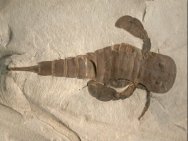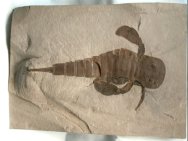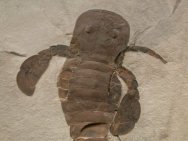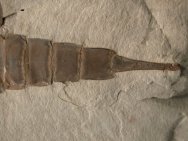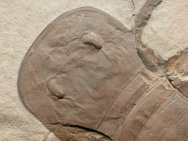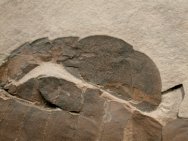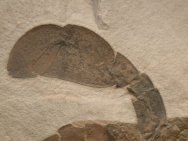Eurypterus remipes
Phylum Arthropoda; Subphylum Chelicerata; Class Merostomata; Order Eurypterida; Family Eurypteridae
Geological Time: Upper Silurian (~410 m.y.a.)
Size: 175 mm long
Fossil Site: Bertie Group, Fiddler’s Green Formation, Phelps Waterlime, Herkimer County, New York
Though they are globally dispersed, eurypterid fossils are uncommon in the fossil record because of the special conditions needed for preservation of their exoskeleton that was not mineralized. Thus, fossils sites preserving them are generally restricted to Lagerstätten having anoxic conditions. Such conditions existed in several fossils site within New York’s Bertie group from which this Eurypterus remipes comes, that were possibly breeding pools. Eurypterus is New York's state fossil. Placed in Subphylum Chelicerata, Eurypterids are likely a sister group of Class Arachnida, and are noted for sharing ontogenic (i.e., morphogenesis) traits with modern xiphosurans, the horseshoe crabs (see Carboniferous Horseshoe Crab Fossil Euproops rotundatus). Over their run from the middle Ordovician until the end of the Permian a distinct trend is seen in the fossil record that indicates increasing migration to freshwater habitats from the Carboniferous to the Permian prior to their extinction.While typically less than a foot long, the species Jaekelopterus rhenaniae known from the Devonian in Germany reached more than 8 feet, based on the 46 cm fossil claw. This makes it one of the two largest arthropods known from the fossil record, and probably the very largest (Cressy, 2007). Such giant creatures are often attributed to one of three factors: 1) supercharged development by climbing atmospheric oxygen levels; or 2) an evolutionary arms race gone wild in parallel with its trilobite prey; or, 3) a paucity of vertebrate predator competition, all of which are plausible in Paleozoic paleobiology. Jaekelopterus is thought to have hunted fresh waters of inland lakes and rivers. The genus has also been recently described from Wyoming (Lamsdell, 2013).
|
||||||||||||
